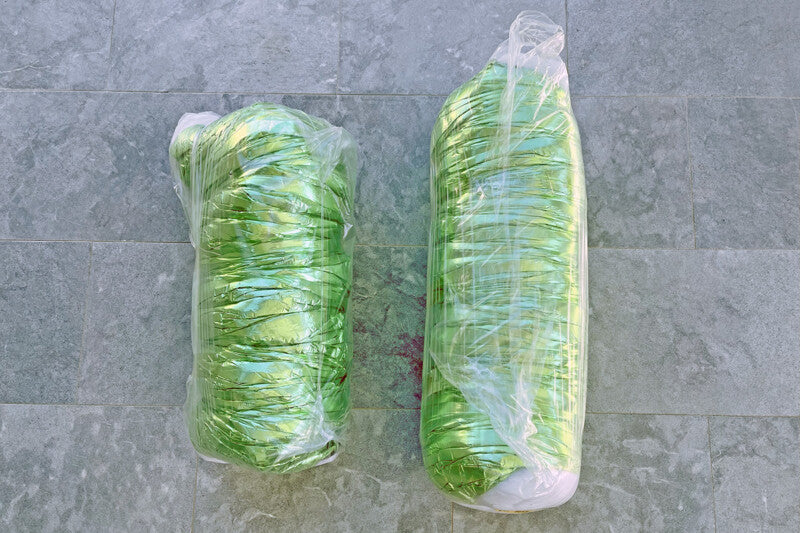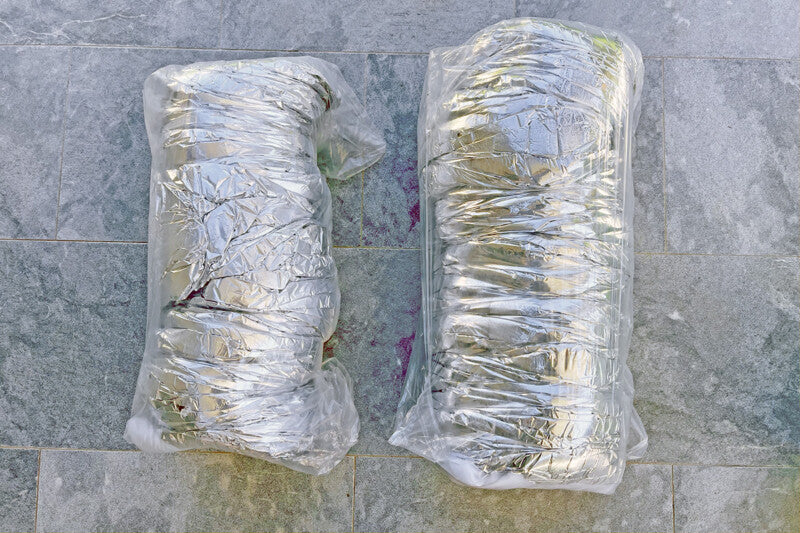




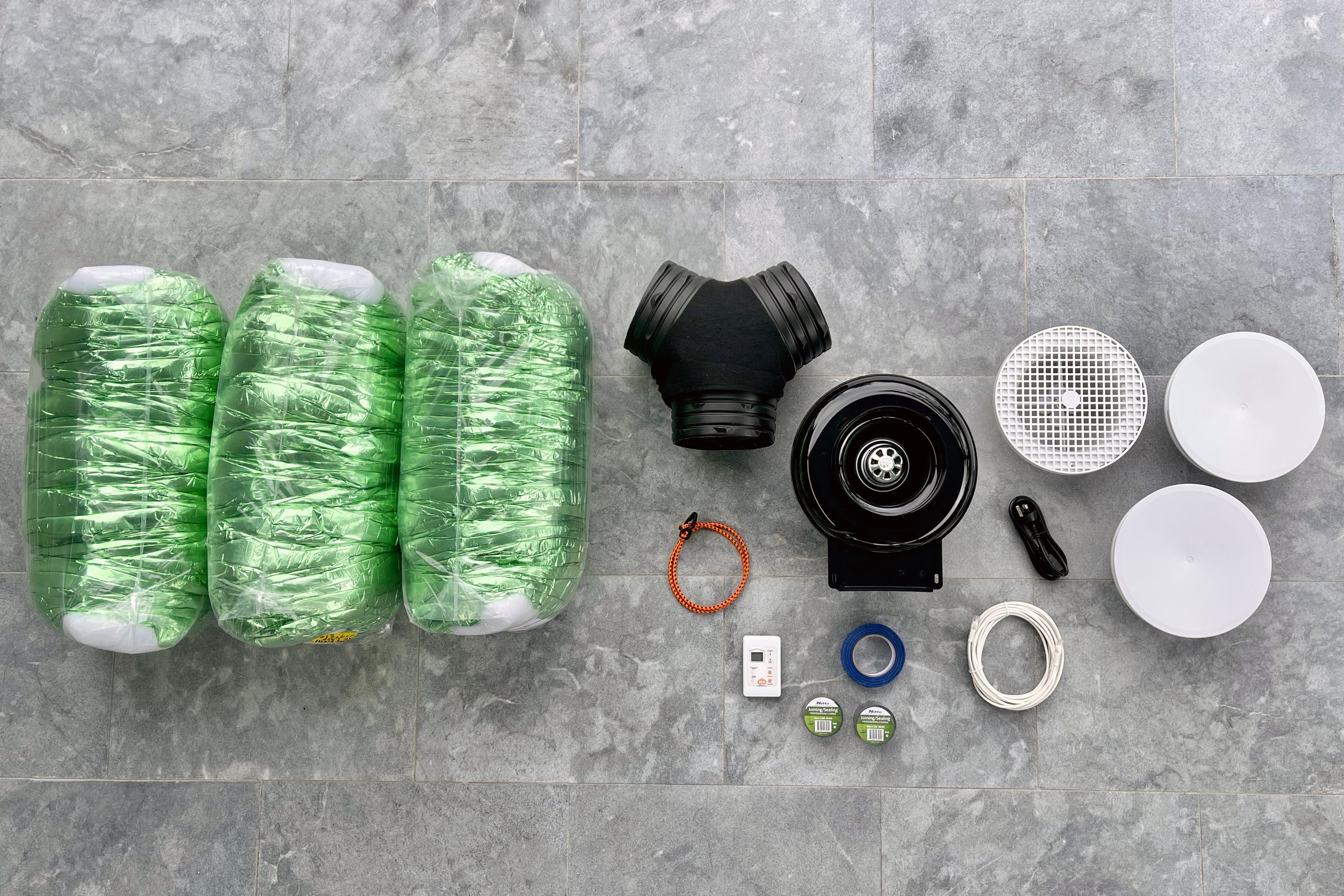

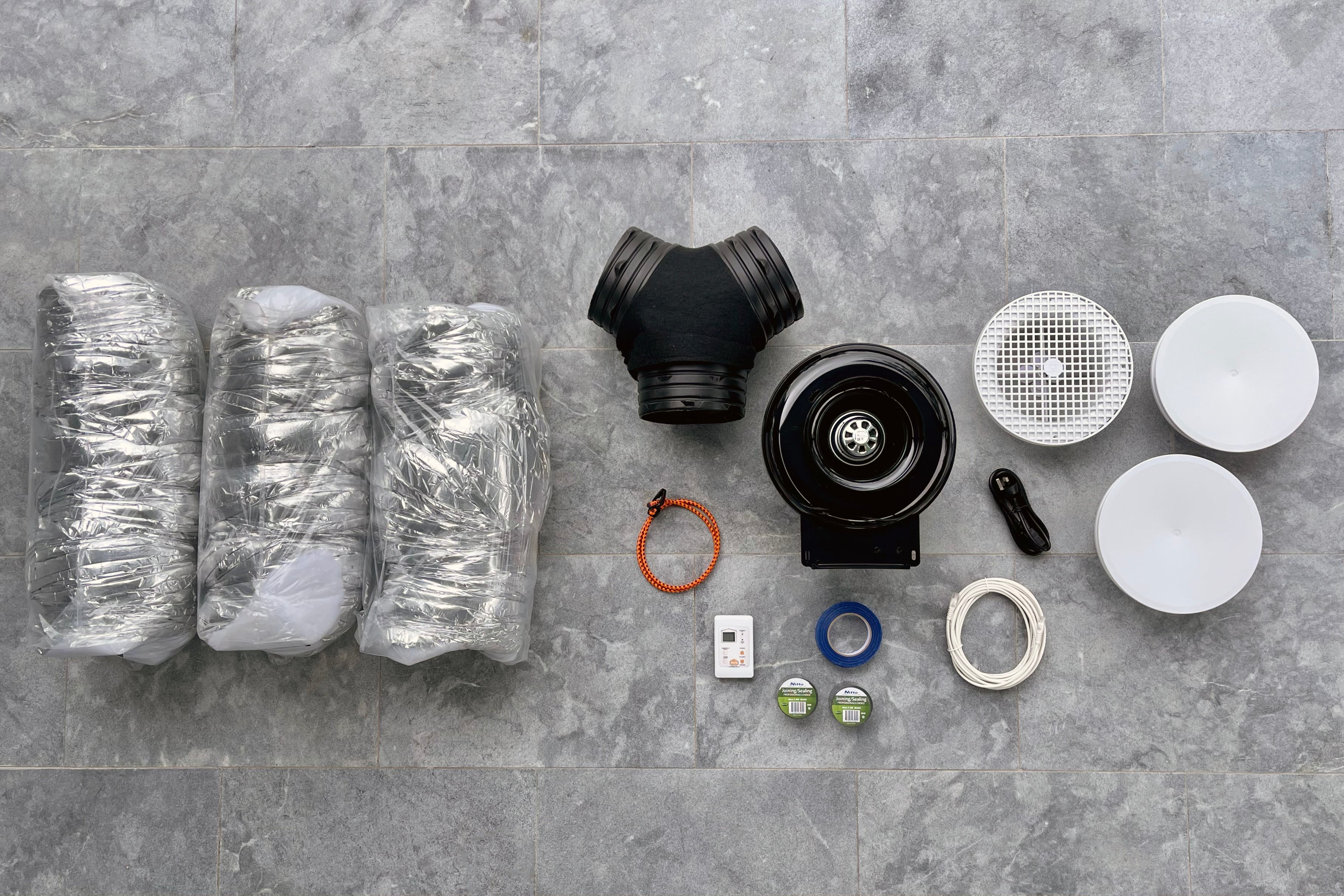



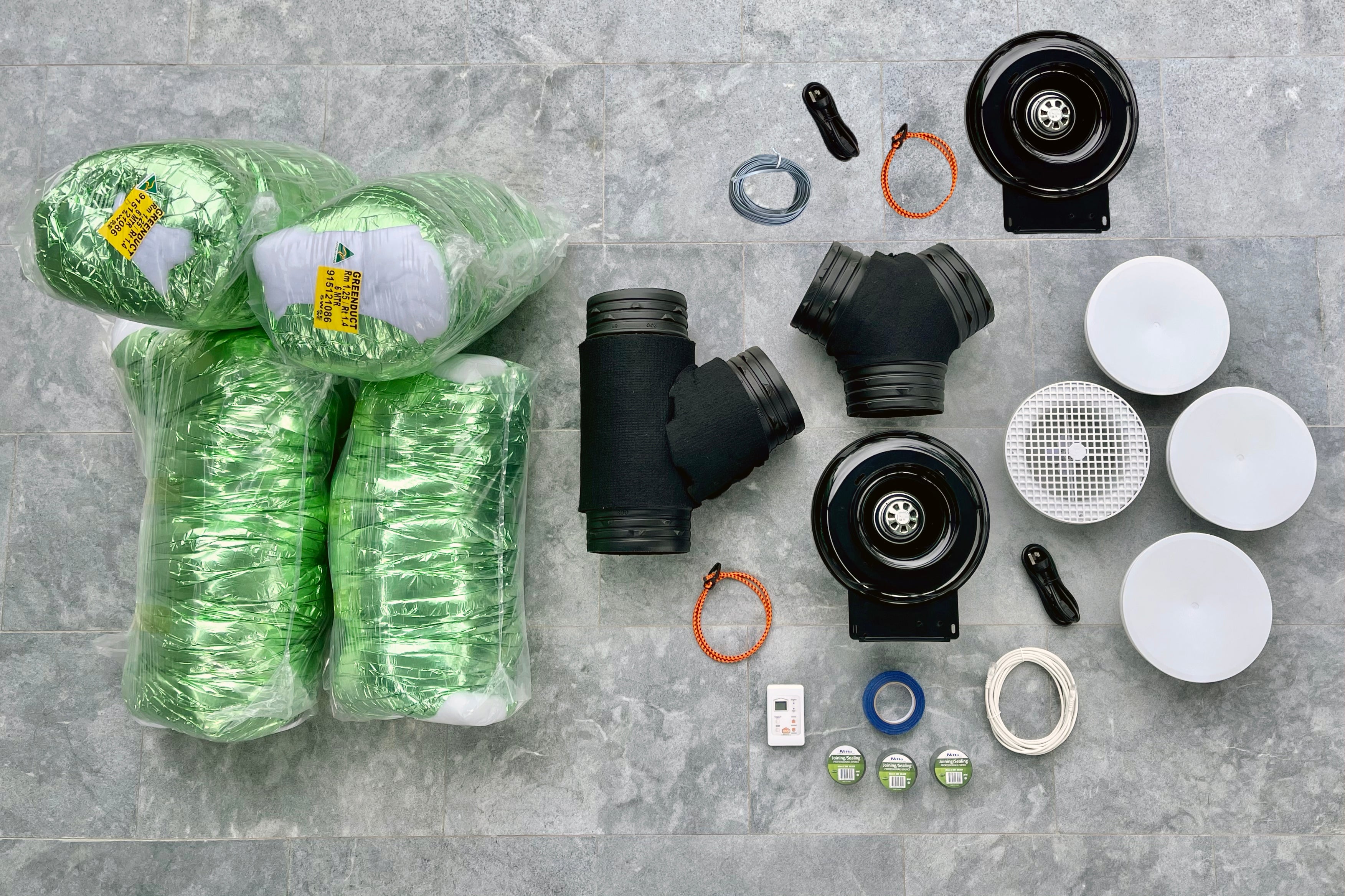







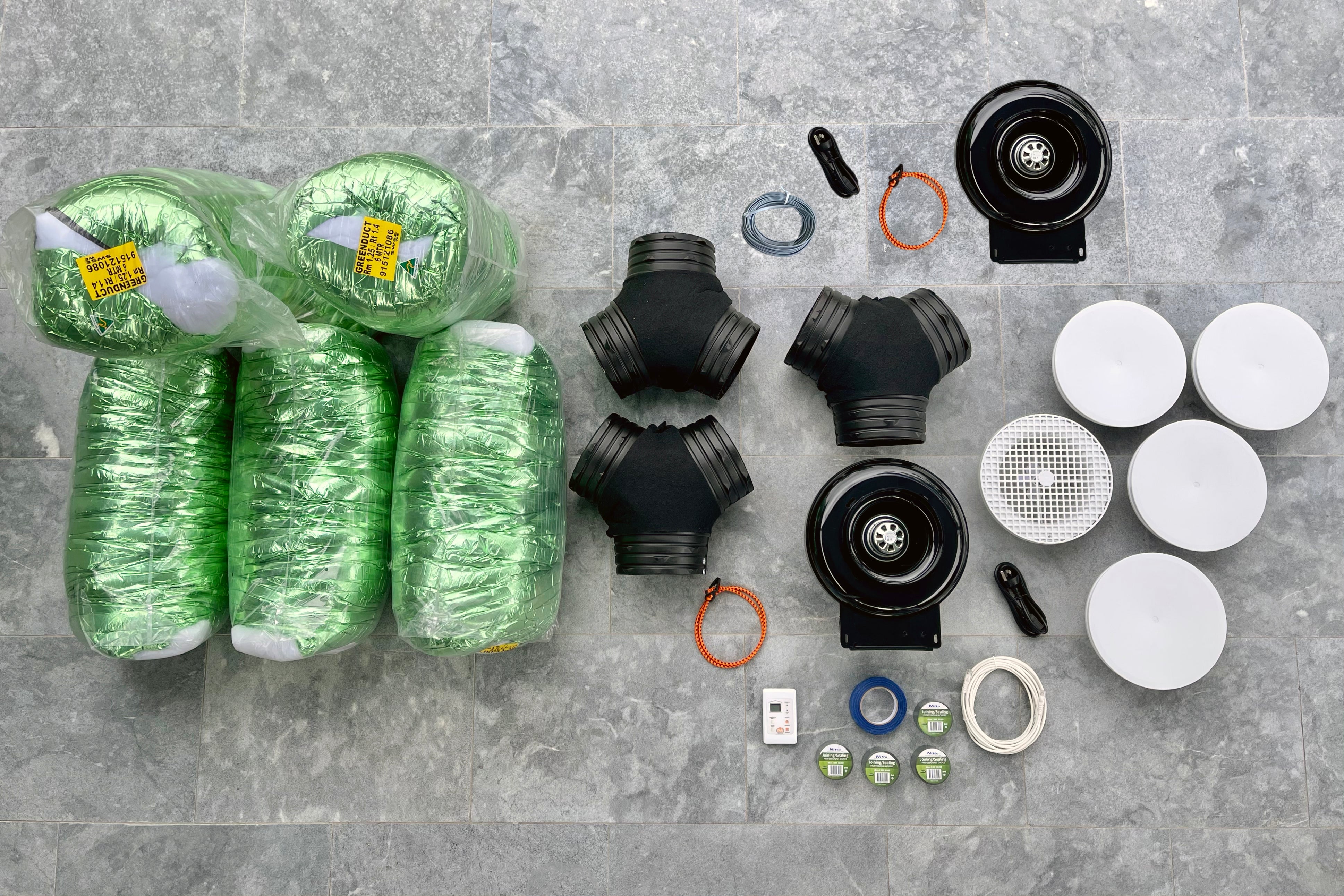






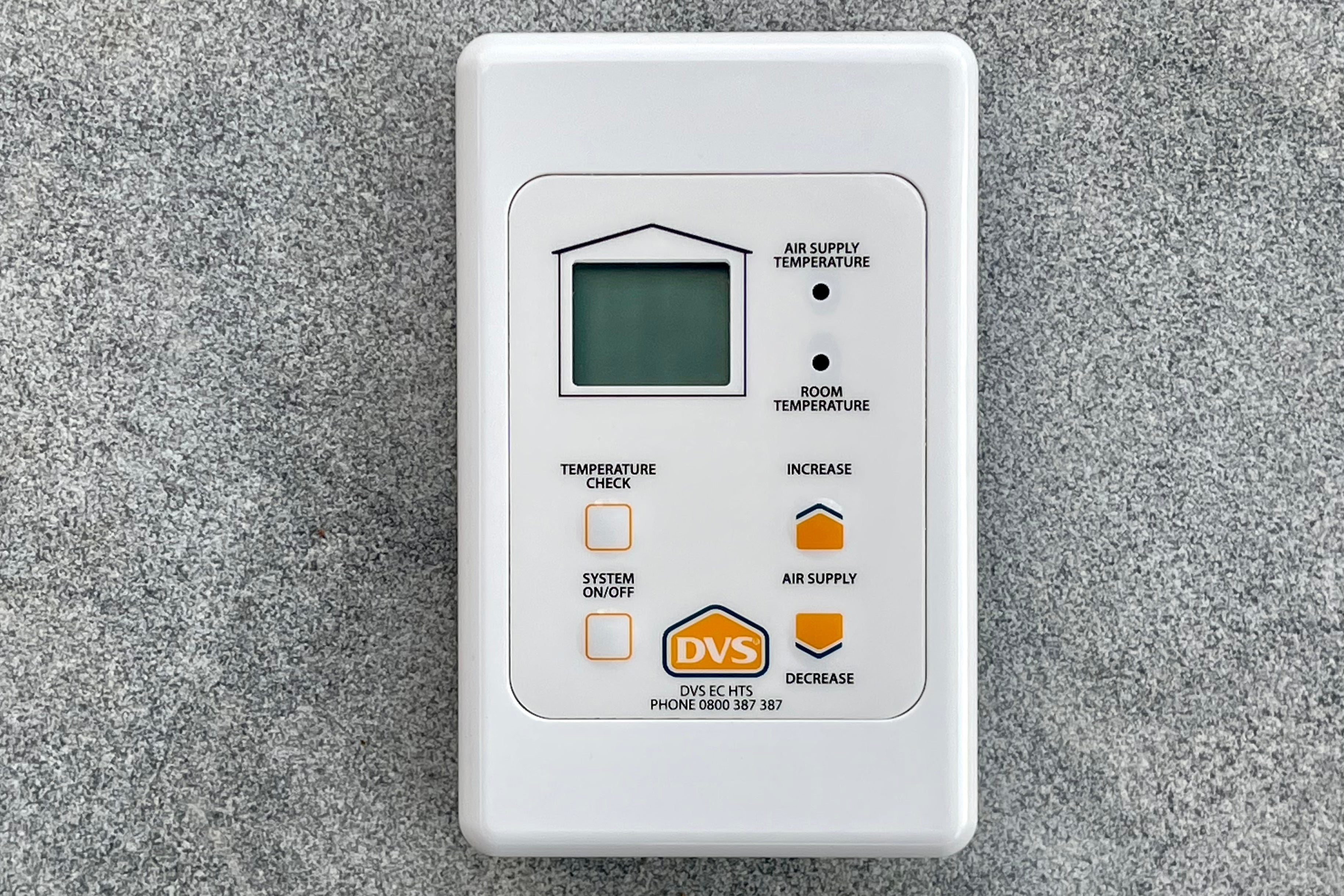



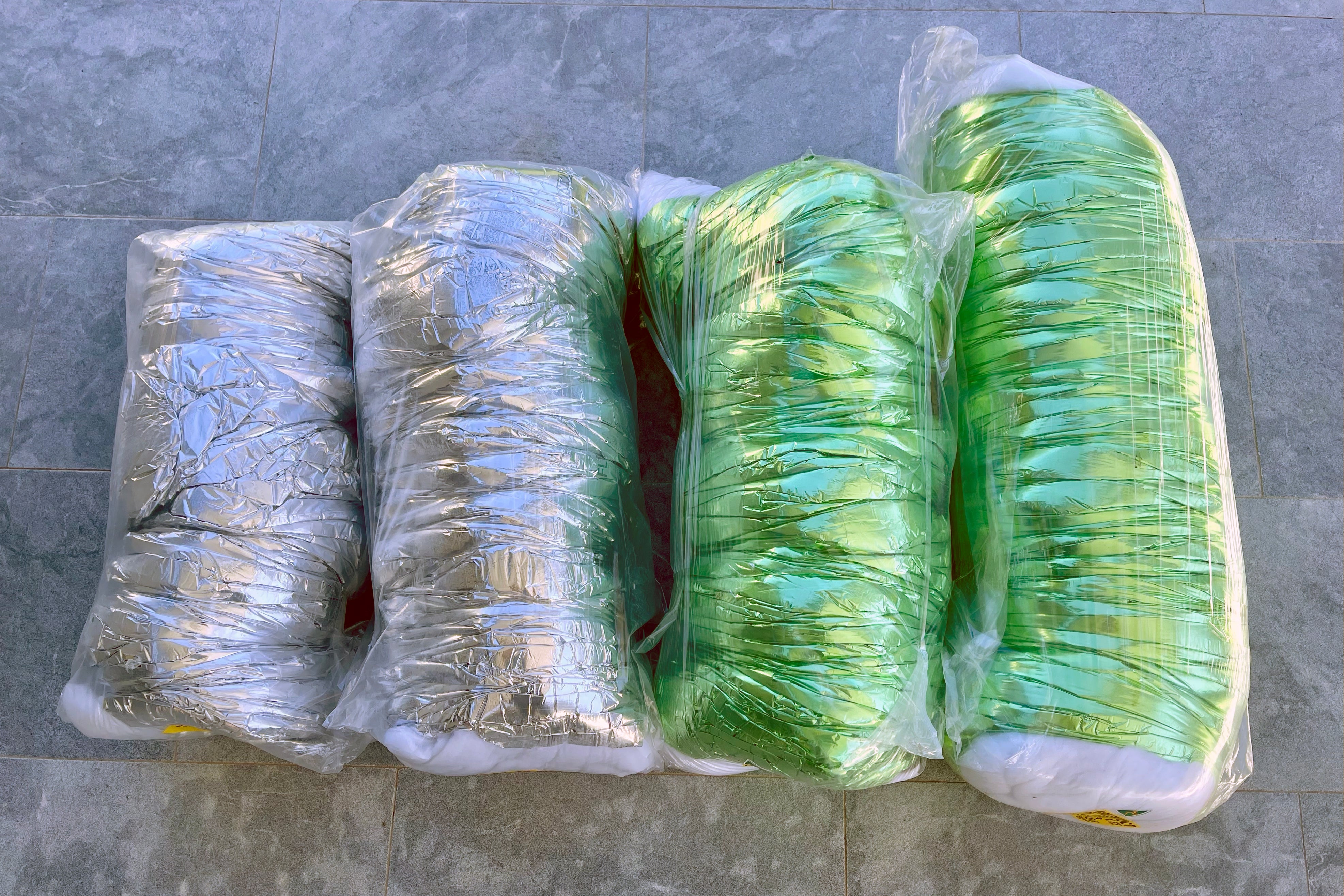



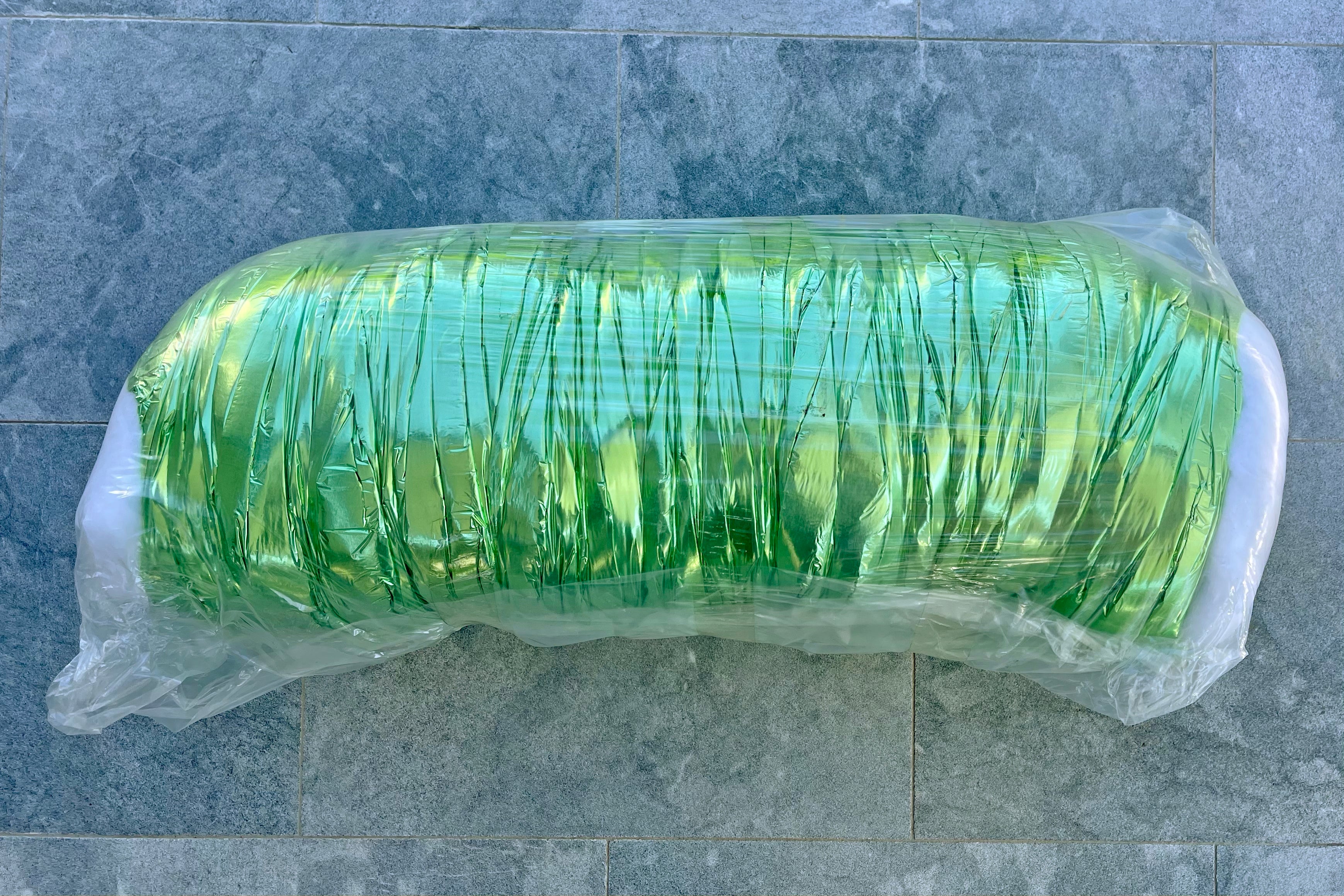


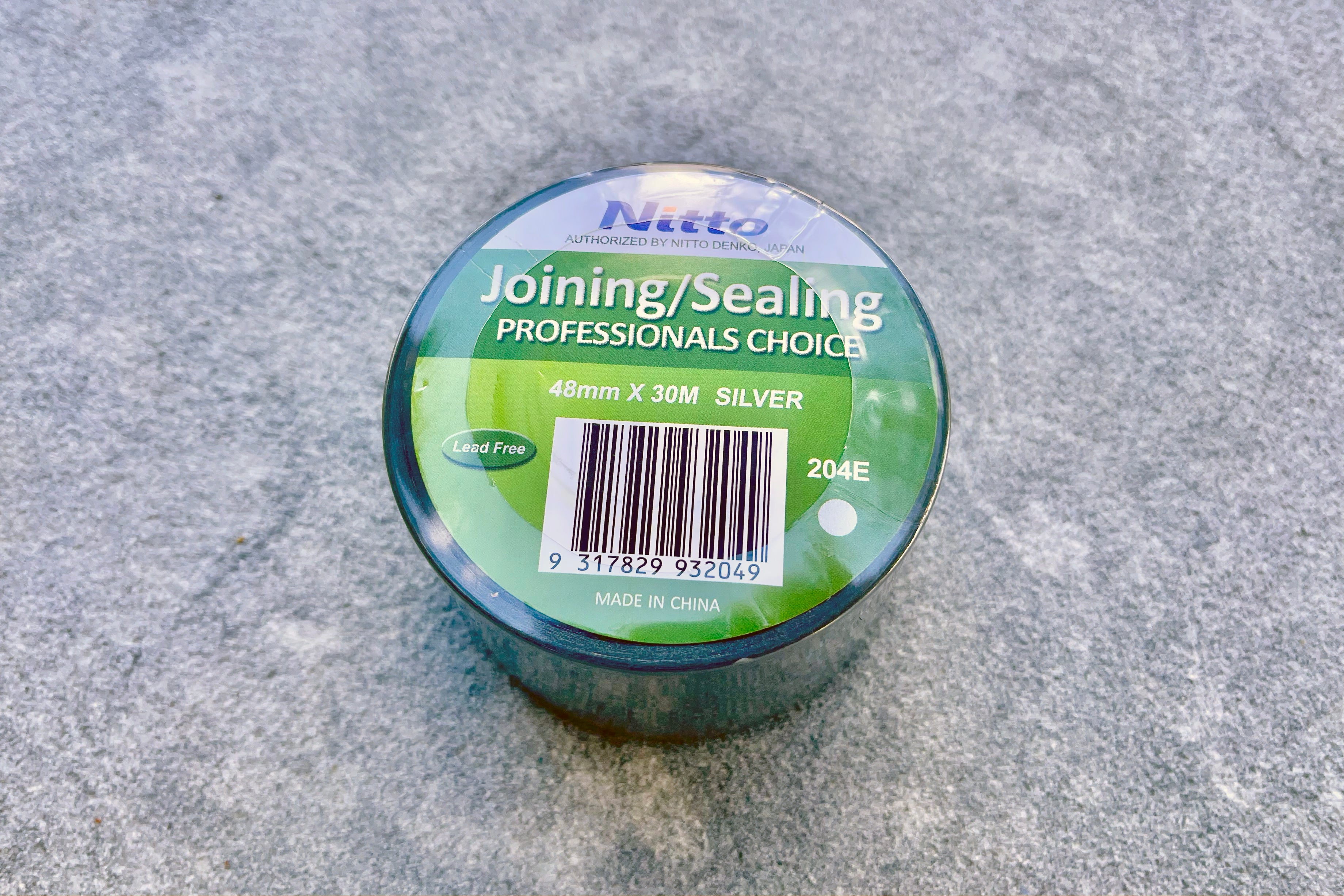

DVS Heat Transfer Kits (EC Motors)


Let customers speak for us
System Sizing
The following table outlines useful information, such as quantities of included items and coverage area, for each of our DVS heat transfer kits.
Additional quantities of individual items can be purchased in our store.
1 Room
2 Rooms
200mm DVS EC Heat Transfer Fan
200mm DVS EC Heat Transfer Fan
1
2
1
1
12 m
18 m
0
1
0
0
30 m
60 m
50 m
50 m
1
1
2 (Fan Motor and LED Controller)
2 (Fan Motor and LED Controller)
10 m
10 m
Yes
Yes
Yes
Yes
Yes
Yes
Yes
Yes
3 Rooms
4 Rooms
200mm DVS EC Heat Transfer Fan
200mm DVS EC Heat Transfer Fan
3
4
1
1
24 m
30 m
1
3
1
0
90 m
120 m
50 m
50 m
1
1
2 (Fan Motor and LED Controller)
2 (Fan Motor and LED Controller)
10 m
10 m
Yes
Yes
Yes
Yes
Yes
Yes
Yes
Yes
Components
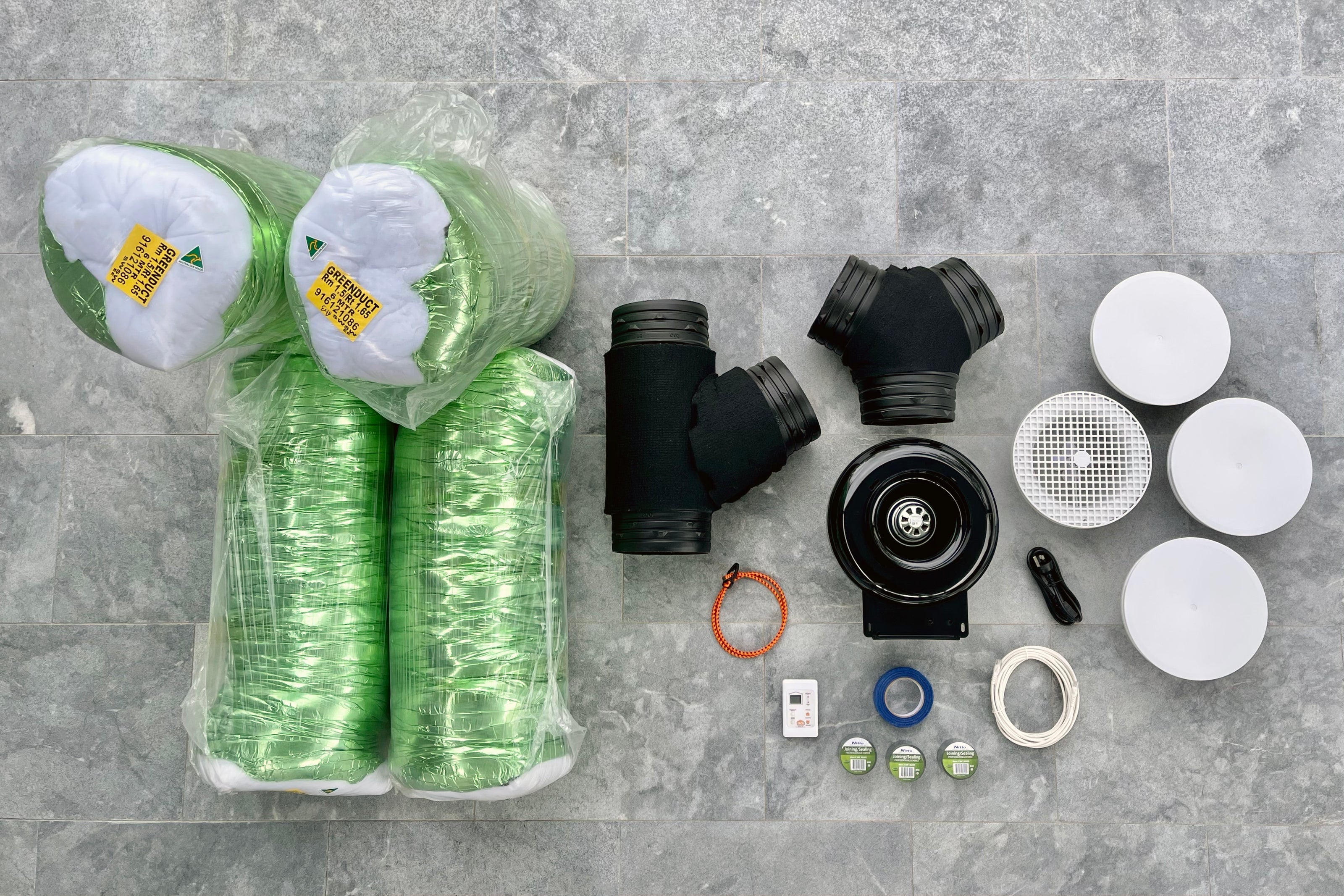
DVS 200mm EC Motor Centrifugal Fan
This is the motor. It is very quiet and efficient. It is suspended in your roof space by the orange bungee strap so that vibrations can't be transferred through the structure. It has an internal temperature sensor to measure the temperature of the air being transferred.
200mm Insulated Branch (Left) and 200mm Insulated Splitter (Right)
These are connected to the fan via ducting and split one airstream into two or more, allowing you to transfer heat to multiple rooms. The branch sends less air to the side and more air forwards whereas the splitter sends equal amounts of air left and right. They are insulated to prevent heat loss.
200mm Insulated Duct
This insulated duct is made in Australia and joins all of the components of the system together. It is much stronger and better insulated than similarly rated imported flexible duct.
200mm DVS Egg Crate Grille (Left) and 200mm DVS Flat Diffuser (Right)
These custom moulded white plastic diffusers are installed in your ceiling and require a 226mm cutout. The egg crate grille is used as the intake above your heat source. The flat diffusers are used in each of the destination rooms. Each flat diffuser includes two 90 degree wedges allowing you to direct (or block) airflow in certain directions. They are connected to the fan via ducting.
DVS EC Heat Transfer LED Controller
The intuitive controller features temperature display, thermostat automation, fan speed control, and on/off operation. It is connected to the fan via a standard Cat 5e network cable, for simple plug and play operation. It has a temperature sensor to measure the air temperature in the room where it is installed.
Fan Specifications / FAQ
AC motors are cheaper than EC motors but still provide excellent performance. They are very quiet during operation and move large volumes of air through ducting. They operate at one fixed speed where they are most efficient.
In real world use, EC motors provide even higher air flow, are extremely quiet during operation, are capable of silent operation at reduced fan speeds, have smoother fan rotation, and consume almost no power at reduced fan speeds. EC motors have adjustable speed and are very efficient at all speeds.
An electronically commutated (EC) motor is designed to run on an alternating current (AC) power supply, but it in fact bears a closer resemblance to a direct current (DC) motor. It is essentially a permanent magnet, brushless DC motor that incorporates on-board electronics. The added electronics allow an EC motor to combine the best features from both AC and DC motors, and then improve on them. For this reason, an EC motor is in a category of its own.
By utilizing this technology, EC fans are highly efficient and pay for themselves through lower operating costs and extended service life. They also provide many operational benefits that are often overlooked.
EC motors use permanent magnets and electrical windings to generate their magnetic fields, in a similar fashion to brushed DC motors. However, as their name suggests, they achieve commutation electronically rather than mechanically. This is only possible by incorporating on-board electronics within the housing of an electronically commutated EC motor.
The on-board electronics include a rectifier that converts the AC supply to DC. An integrated controller then directs the right amount of current, in the right direction, at the right time, through each of the windings. This develops magnetic poles in the stator, which interact with the permanent magnets in the rotor.
The position of each magnet is determined by using Hall effect sensors. The appropriate magnets are attracted, in sequence, to the magnetic poles in the stator. Simultaneously, the rest of the stator windings are charged with the reverse polarity. These attraction and repulsion forces combine to achieve rotation and produce the optimal torque. Since this is all done electronically, precise motor monitoring and control are possible.
Energy Efficiency
EC motor efficiency is often above 90%, allowing EC fans to consume up to 70% less energy, when compared to conventional fans. Running an EC fan at 80% speed saves nearly 50% of the energy.
Ease of Control
By continuously monitoring motor functions and automatically adjusting the control input, high efficiency is maintained throughout the operable speed range. EC motors are often capable of being turned down to 20% of full speed, while still maintaining 85% efficiency. Sensors that produce a 0-10V signal provide speed control without the need for a complex variable frequency drive.
Versatility
EC motors are capable of exceeding rated speeds. This allows fans with EC motors to achieve higher capacity within a smaller fan package.
EC motors are variable speed motors. They use a 0-10V potentiometer to adjust their speed precisely between 0% and 100%.
This is built in to the DVS heat transfer control panel.
DVS EC heat transfer fans have a maximum capacity of approximately 1,015 m³/h.
DVS EC heat transfer fans draw 84 W when running at 100% speed.
DVS EC heat transfer fans make 33 dB(A) noise (3m breakout) when running at 100% speed.
Maximum absorbed power: 84 W.
Maximum delivery: 1,015 m³/h.
Pressure max: 335 Pa.
RPM: 2,500.
Maximum absorbed power: 40 W.
Maximum delivery: 795 m³/h.
Pressure max: 236 Pa.
RPM: 2,200.
Maximum absorbed power: 22 W.
Maximum delivery: 650 m³/h.
Pressure max: 158 Pa.
RPM: 1,800.
Maximum absorbed power: 10 W.
Maximum delivery: 505 m³/h.
Pressure max: 95 Pa.
RPM: 1,400.
The fan motors are manufactured by ebm-papst in Germany.
DVS EC heat transfer fans use a R3G220 motor.
The fan motors are made in Germany.
The fan housings are made in New Zealand.
The fan motors have a 5 year warranty.
Available insulated to Rm1.25 and Rm1.5.
Made in Australia.
Fire rated.
Complies to AS 4254.
Inner core has a steel rib for strength.
Inner core is not prone to glue failure.
Insulated with polyester fibre.
Outer jacket is reinforced with cotton for strength.
Operating temperature range: -10°C to +80°C.
Available insulated to Rm0.6 and Rm1.0.
Made in Australia.
Fire rated.
Complies to AS 4254.
Inner core has a copper coated spring steel wire designed for applications that require less rigid insulated duct.
Insulated with polyester fibre.
Operating temperature range: -10°C to +80°C.
DVS EC Heat Transfer Systems
While you may have a perfectly good heating source in the living area (such as a wood burner), the heat it generates does not always extend to other areas, such as the bedrooms. The DVS EC Standalone Heat Transfer System uses excess heat from your existing heating to create supplementary heating for other rooms in your home – making the best use of heat you’ve already paid for.
The DVS EC Standalone Heat Transfer System is designed to provide supplementary heating to rooms isolated from the main heating source (log burner or other solid fuel burner). This can have the effect of reducing the amount of in room ‘paid for’ heating you need to use.


DVS EC Heat Transfer Control Panel
The DVS EC Heat Transfer System features an intuitive controller with temperature display, thermostat automation, fan speed control, and on/off operation.
It is connected to the fan via a standard Cat 5e network cable, for simple plug and play operation.
Click Here to download a User Manual for the DVS EC Standalone Heat Transfer Controller.

DVS 200mm Flat Diffuser
Custom moulded DVS diffusers that are both attractive and designed specifically for ventilation.

Why Choose a DVS EC Heat Transfer System?
The DVS EC Heat Transfer System is the most advanced standalone heat transfer system on the Australian market. It uses a German made 200mm EC centrifugal fan and has an intuitive custom designed controller with temperature display, thermostat automation, fan speed control, and on/off operation.
Some of the many benefits include:
Our 200mm EC motor centrifugal fan transfers up to 1,015 m³ of air per hour. This is a large volume of air compared to some competing fans which only transfer 223 m³ of air per hour. Destination rooms are often very cold. When only a small amount of heat can be transferred, it is unlikely to make a difference.
Our EC motor centrifugal fans are infinitely speed controllable. The fan speed is directly proportional to the size of the adjustment you make on the speed controller. Many fans are only single speed. Every heat source is different and every house is different. Precise speed adjustment allows a heat transfer system to be matched to its surroundings. Speed adjustment allows a heat transfer system to move a small amount of air at times when the heat source is not operating.
Our 200mm EC motor centrifugal fan makes only 39dBA noise at 50% fan speed. This is very quiet compared to some single speed fans which make 51dBA noise when operating. Heat transfer systems work best when they are operating all the time. This means they are often operating at night. A quiet fan with controllable air flow is less likely to disturb your sleep.
Our 200mm EC motor centrifugal fan uses only 22 W at 50% fan speed but still transfers 650 m³ of air per hour. This is very energy efficient compared to some single speed fans which use 193 W when operating. Heat transfer systems work best when they are operating all the time. An energy efficient fan will save a lot of money over the long life of the system.
Our EC motor centrifugal fans can operate in temperatures up to 60°C and are rated to 80°C when not in use. This is a high operating temperature compared to some fans which have a maximum air temperature of 45°C. The purpose of a heat transfer system is to transfer hot air. Heat transfer systems are often installed in roof cavities which are hot during the day in summer.
High quality insulated duct is essential for minimising heat loss if you want your heat transfer system to work well. Despite this, almost all heat transfer systems use poor quality and poorly insulated duct, which leads many people to believe that heat transfer systems do not work.
Fresh Ventilation conducted the following experiment in the Southern Highlands. The incoming air from the heat source was 32°C, the air in the roof space where duct was located was 5°C, and the transfer length was 18 metres. The air temperature was then measured at the destination. The air exiting from uninsulated duct was 16°C, a loss of 16°C. The air exiting from Rm0.6 standard insulated duct was 21°C, a loss of 11°C. The air exiting from Rm1.5 green insulated duct was 31°C, a loss of only 1°C.
Green Duct is available insulated to Rm1.5 surrounded by 90mm of insulation. This is 150% more thermally efficient than duct insulated to Rm0.6 surrounded by 40mm of insulation. High quality insulated duct is essential for minimising heat loss if you want your heat transfer system to work well.
Green Duct’s inner core has a steel rib for strength and is not prone to glue failure. This is much stronger than cheaper duct that is prone to collapsing and tearing. Insulated duct is often mistreated by people moving through a roof space. High quality insulated duct will last a long time and is more likely to withstand poor treatment.
Green Duct is fire rated and complies to AS 4254.
It uses a German made 200mm EC centrifugal fan which has a temperature sensor inside to measure the temperature of the air being transferred.
It has an intuitive custom designed controller that can also measure the room temperature where it is installed.
The controller features temperature display, thermostat automation, fan speed control, and on/off operation.
DVS ventilation products are designed for the harsh Australian and New Zealand climates.
Our 200mm EC centrifugal fan motors are made byebm-papstin Germany.
The DVS EC Heat Transfer System features an intuitive controller with temperature display, thermostat automation, fan speed control, and on/off operation.
It is connected to the fan via a standard Cat 5e network cable, for simple plug and play operation.
The fan has a temperature sensor inside to measure the temperature of the air being transferred.
The control panel can also measure the room temperature where it is installed, so that the system can be automated whenever there is warm air available.
Multiple temperature sensors enable the system to automatically switch on whenever warm air is available.
DVS diffusers are both attractive and designed specifically for ventilation.
Backed both by DVS on their product and Fresh Ventilation on supplied components.
What Makes Fresh Ventilation Different
Fresh Ventilation is a family owned and operated business. Our main business has specialised in the installation of premium quality ventilation systems for over 10 years.
Effective heat transfer systems require quality components and proper installation. Given that no two homes are the same, there is no one-size-fits-all solution to heat transfer systems. This is why we place a strong emphasis on customised solutions and after-sales support to help you get the most from your system.
Our focus is on premium products and expert advice to create ventilation systems that actually work.
All of our kits include:
Personal installation maps tailored to your home.
One-on-one conversations to help us understand what is going on and recommend how best to solve it.
One-on-one telephone and/or FaceTime conversations to help you with installing your system.
Installation photos and videos outlining best practices and things to avoid.








